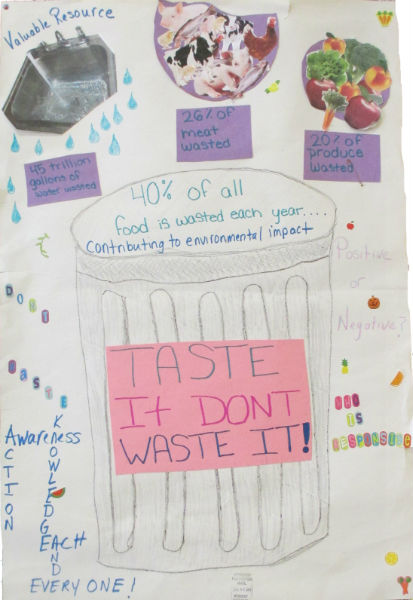Food Waste and Food Insecurity

November 17, 2015
Everyday at 10:33 am or 11:02 am, a little over 400 students rush to the cafeteria to do what all growing kids or teens/young adults do best: eat! As a part of the human race (especially for young minds and growing bodies), we all love food. Along with sleep, which we don’t get that often, we turn to food for the most stable energy. We all know that food helps us grow and stay nourished. However, everyone is still hungry.
Yes, school does provide these lunches during the year, but how about when everyone is off the clock? Such as after school or during the summer or holiday breaks? Where do students who live in a home where food is hardly available go to eat? School may be the only place to get food. This is the definition of food insecurity.
In America, 21.1% of children under 18 live in poverty. 48.1 million Americans live in food insecure homes. 6% of households experienced food shortage. Households with minors experience food insecurity more than adults. The definition of food insecurity is when a family can’t afford food and those individuals have rare chances of eating. Overall, food insecurity is affecting this country greatly. It’s also affecting our community in Cherry Hill and at Cherry Hill West. 1 in 7 students at West experience this food insecurity. This is a surprisingly growing problem in our area.
Thousands of people turn to food banks and one of them is St Michael’s Lutheran Church Food Bank in Cherry Hill. “This year we would end up with more clients than ever!” Janis, head organizer of the St Michael’s Lutheran Church Food Bank, exclaims. St Michael’s Lutheran Church proudly organizes a food bank that gives to registered families who are struggling. The organization’s client rate was at its largest in 2010-2011. A year later, the rate decreased a little and then increased even greater as time went on. Recently, they had a little over 900 families registered and on a regular basis they have 500 families walk every month. This organization provides individuals with all types of food, even red meat and chicken. Around November and December, this food bank organization had nearly 700 families come for a holiday meal. A total of 350 kids (infant-17 years old) are within those food insecure families and come to this food bank. “Things are more expensive. It’s harder to get jobs and the economy is really bad,” says Janis on the reason why kids and their families are struggling. Although there are food banks, not every family or minor can gain access. This relates to those 1 in 7 West students that experience food insecurity. When you think about it, this is an enormous amount of kids and families who need help receiving breakfast, lunch or dinner.
How can this be fixed, if people are not able to register or get accepted for these food banks? One possibility could be coming together as students and convincing Aramark to help our school to benefit some of these students who are living with food insecurity. It will take some work to get a big company’s attention, meaning it would take a lot of letters from students to get that attention. You and other students could write or email ideas from mostly everyone who can participate; hopefully then Aramark would follow through. Possibly Aramark can provide goody bags for West students before they leave to go home at the end of the school day. This can prevent kids from going to bed and waking up in the morning hungry. Another option is to encourage others at West to have a food drive at least once or twice a month. Having a food drive once or twice a month could sustain so many at West.
Having a food drive once or twice a month would be a more sustainable choice. Not only can the struggling students have food once in awhile, but frequently. You can work with any school club to help plan out a canned good drive in the cafeteria. We can encourage students to donate in the announcements and hang posters around. Students who donate can have a little incentive: whoever donates the most canned goods receives a $15 gift card to Wawa or Chick-fil-a. Not only are you receiving the good warm feeling of giving, but you could also get a gift card out of it as well. It would be a great way to get students involved in community service and help with food insecure individuals. It’s a win-win situation for everyone.
